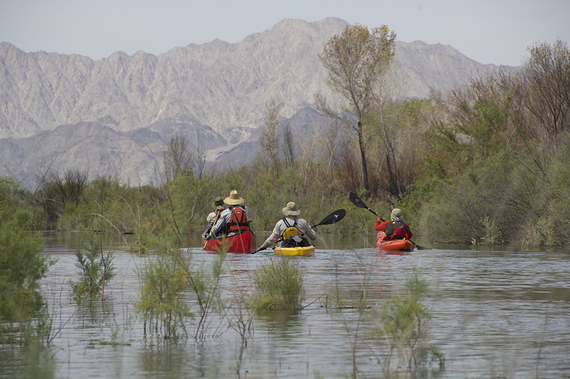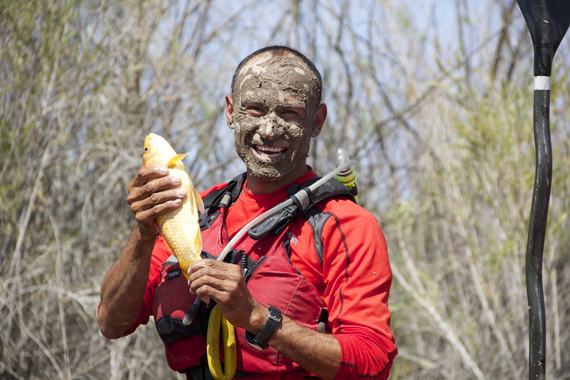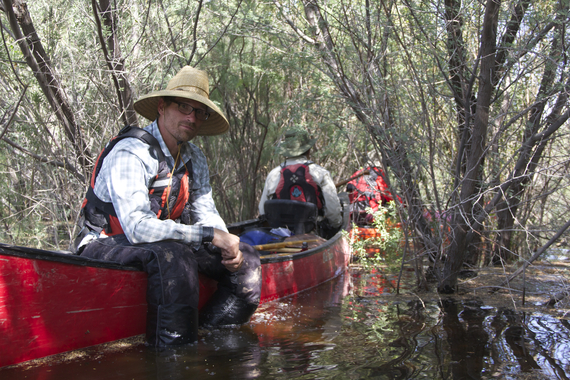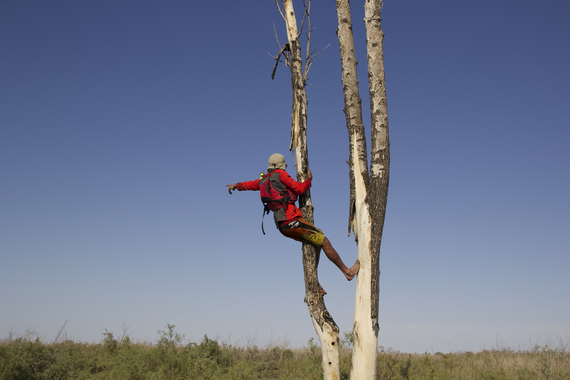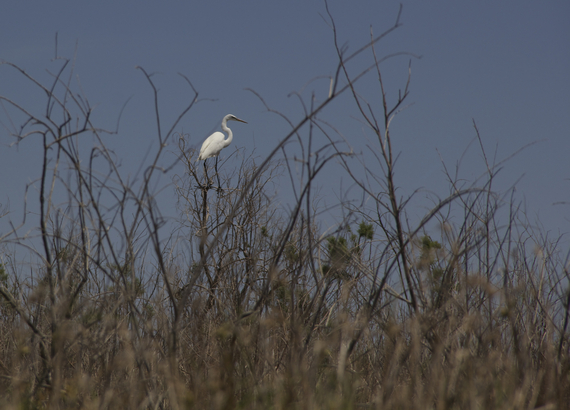
The bow of my kayak parts the soft tops of tamarisk trees as we glide down a straight bulldozed pilot channel in the Colorado River's delta. The water is cool and clear. Fish dart amid scrub brush that, just days earlier, had been surrounded by miles of bone-dry desert.
The last time I was here I was hiking amid sandy truck tracks, old tires and scattered trash that filled the former riverbed. It also was my first day on foot after more than 100 days on the water. My friend Will Stauffer-Norris and I had arrived in early 2012, after paddling 1,700 miles from the source of the Green River in Wyoming only to lose the remnants of the river in the vast complex of concrete irrigation canals that begins at the U.S.-Mexico border. From the border fence to the sea, our trip consisted mostly of cracked mud flats, anxious camping in Mexican alfalfa fields, and walls of the invasive tamarisk so thick that the painstaking crawl through them would have made Tai Chi classes and DMV lines appear rushed in comparison.
When we finally made it to the Gulf of California, I'd already decided I wouldn't return to the delta until the river did. I assumed this meant I'd never be back.
But within just two years of our source-to-sea trip, the impossible happened. Decades of work by environmental groups such as the Sonoran Institute, Environmental Defense Fund, The Nature Conservancy and Pronatura paid off, and Minute 319 was added to the Colorado River treaty between the U.S. and Mexico. For the first time in history, two nations decided to share a river that had long been used down to its last drops, not only with each other but with the environment. On March 23, 2014, the gates of the Morelos Dam -- which had been the end of the line for the river almost continuously since the 1960s -- were opened. Water poured out into the sand below and began snaking its way down its old course. Teams of hydrologists, biologists, and conservationists excitedly tracked the water's progress. Locals who'd spent years living with only the memory of a river in their backyard flocked to the channel. The Colorado River pulse flow was underway.
I knew it was nearly time for me to go back. The question was when. The pulse would last for less than two months, peaking in late March and gradually ramping down until May 18. But timing a trip to the delta was like playing a game of chicken with the water table. Go too soon when the pulse was highest, you'd risk out-paddling the water as it sank into parched ground. But go too late, after the groundwater had a chance to recharge, and you'd risk not having enough release to ride on.
In the end, it was never possible to ride the pulse in one fell swoop. When I arrived on May 8 the upper section was already dry. The ground proved too thirsty for even the 130 million cubic meters (105,000 acre-feet) of released water, and those directing the pulse decided to bypass the worst "hole" in the water table by diverting water roughly 60 miles down the canal system and releasing it into the lower stretch of river.
So our group of five paddlers, brought together for this trip by Canoe & Kayak magazine, launched our boats at Vado de Carranza, a road crossing some 40 miles above the tidal channel where the old Colorado River channel meets the sea.
At the vado I meet a crew armed with cameras, kayaks and the will to follow a river reborn: Jeff Moag, the editor of Canoe & Kayak; Todd Lynch, a San Diego surfer and videographer; Victor Leon, a sea kayaking guide and native of Baja California, and Dr. Jorge Ramirez, a hydrology professor at the Universidad Autonoma de Baja California in Mexicali who's in charge of measuring the pulse flow.
Jeff, Todd, and Victor had floated from the border to just upstream of the vado at the height of the pulse flow in March, and are returning to finish what they started. For the Mexicans in our group, paddling a local river is a once in a lifetime experience. When the lower Colorado dried up, the number of perennial rivers in the Baja states was cut in half, from two to one. It's far easier to find a drive-thru Starbucks in this part of Mexico than flowing fresh water. Jorge has been working as a hydrologist in the area for 30 years, but this will be his first canoe trip. Victor, though he makes his living leading kayak trips on the ocean, had never paddled a river until the pulse flow began.
Victor finds a friend
The first few hours are an easy cruise down an engineered pilot channel. Its levee-lined sides have little resemblance to the pre-dam era delta, which didn't look much like a river at all but met the sea through a vast network of 3,000 square miles of wetlands, lagoons, channels, and estuary. For the local ecology however, the river's artificial aesthetic is far less important than the fact that water has returned. In addition to the fish swimming in the scrubby trees below our boats, we see countless flickers of birds in the bushes and hear their continuous chatter. Over 300 species of birds live in the delta or rely on it as a stop-over in their yearly migration. The Sonoran Institute has long claimed that just a small amount of water would make a huge difference for the delta, and the pulse flow seems to be proving just that. Although the release is being fueled by less than 1 percent of the Colorado's average annual output, species have quickly expanded their range to take advantage of the new habitat.
After three hours of pleasant paddling, the river leaves the pilot channel and spreads out, growing warm, shallow, and brushy. We ease our way under thorny mesquite trees, pull ourselves through willows, and, when we no longer have enough water to float, we drag our boats through mud. Our destination is a permanent arm of water connected to the Rio Hardy, where agricultural runoff creates a kind of slow flowing swamp that connects to the sea at exceptionally high tides. Jorge tells us that if the water from the pulse flow makes it to the Rio Hardy, the Colorado will have reconnected, however briefly, with the saltwater.
Canoe & Kayak editor Jeff Moag pauses to contemplate our predicament
The river spreads across the dehydrated ground and begins to disappear. We're soon spending more time pulling our boats than paddling them. The GPS tells us the arm we're searching for is 400, 300, 200 meters away. The tamarisk grows thicker. Victor and I move ahead to scout on foot.
Victor looks for water
Struggling through the brush, I eventually see the glimmer of water through the branches. I cut back towards the group and can hear their voices clearly through a tangled thicket. Crashing towards them, I'm suddenly back in the delta I remember. The branches are so thick I'm almost suspended off the ground, unable to move in any direction. I try crawling. I try climbing over the top, but I only fall into the middle of a tree, leaving my arms and legs streaked with bloody scratches. The only thing that works is to break down each skinny branch by hand, moving forward at a couple of feet per minute. Victor, back with the group via another route, begins slamming his kayak into the brush from the other side and eventually we meet. Using the boat as a battering ram, we bash our way through the last 60 meters to the Rio Hardy. It's taken us five hours to cover about a mile and a quarter.
Exhausted and bleeding, we regroup on the water. Jorge, otherwise reserved and quite possibly traumatized from his introduction to canoeing, lets some excitement into his voice as he calls our attention a small stream of about 70 cfs spilling into the deeper Rio Hardy channel. He's been tracking the movement of the pulse flow since it began and knows better than perhaps anybody how the water is behaving. He explains there is a 10 percent margin of error in his team's measurements. Since the water from the current release is less than 10 percent of the total flow of the Hardy, there was no way to tell for certain whether the pulse had connected with the sea. The only way to confirm "communication," as he calls it, is to do exactly what we've just done: hack your way in and see for yourself.
In accordance with Minute 319, the simulated flood will soon be over, but a small base flow will continue to feed several restoration sites in the delta until 2017. Reuniting the river with the Pacific, if only for a few days, opened a new chapter in the management of the Colorado River. The success of the experiment demonstrates a growing willingness in our thirsty civilization to spread the water we've become so adept at managing beyond lawns, fields or faucets; it shows our ability to restrain our use just a little and send some of the river back to the river itself.
Click here to read the news story covering the Colorado's first touch into its delta in decades.
A special thanks to the State of the Rockies Project for making these photos possible. All photos by Zak Podmore.
Great egret in the delta

